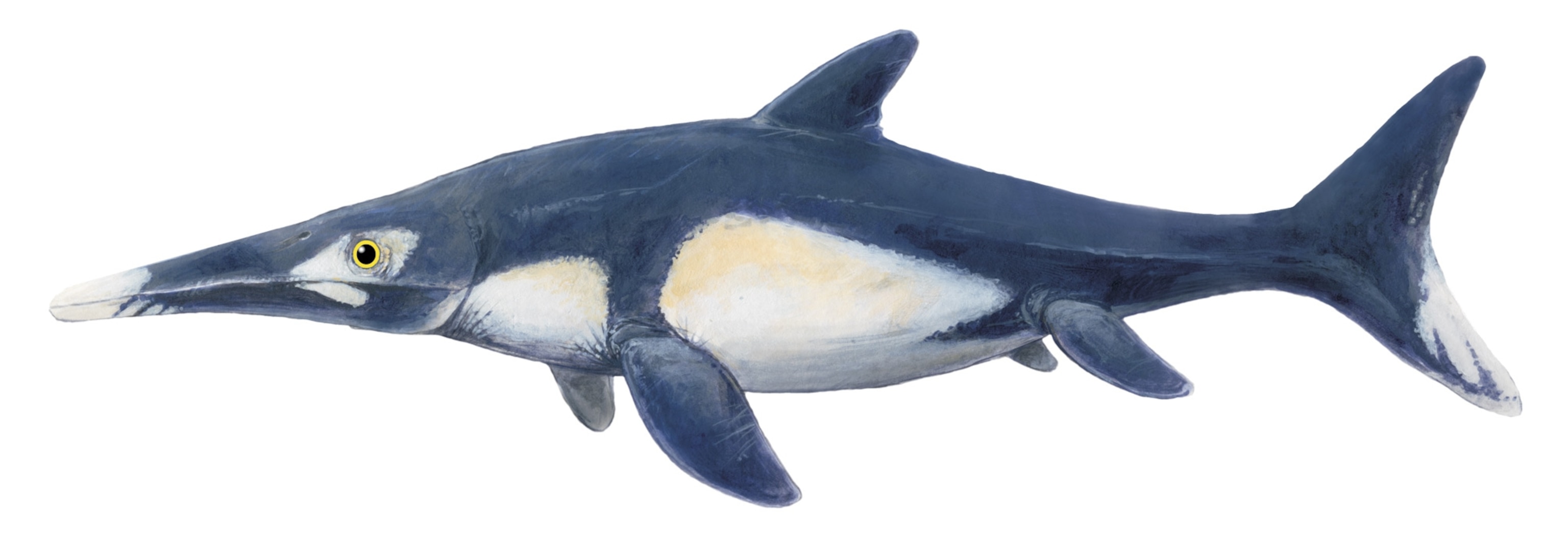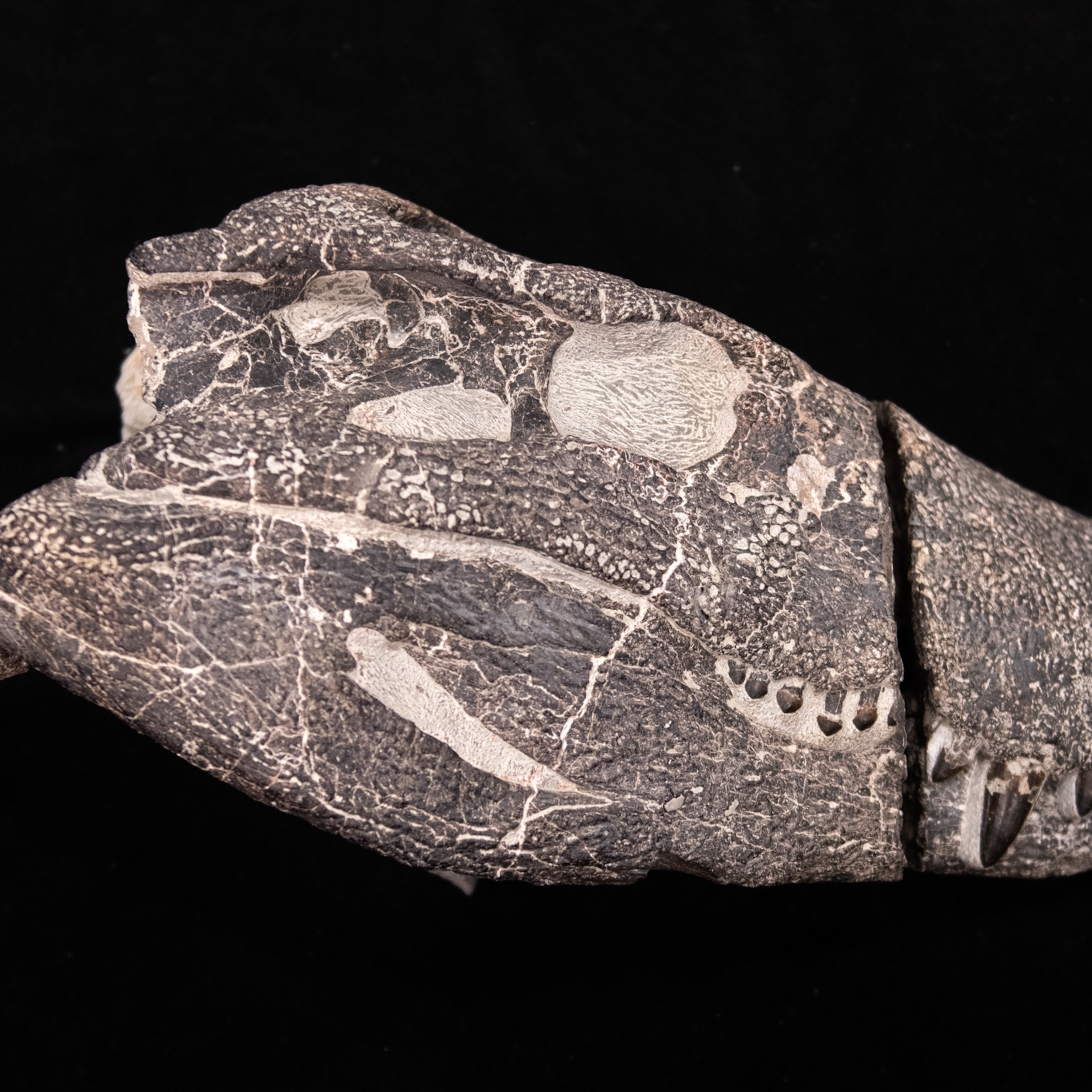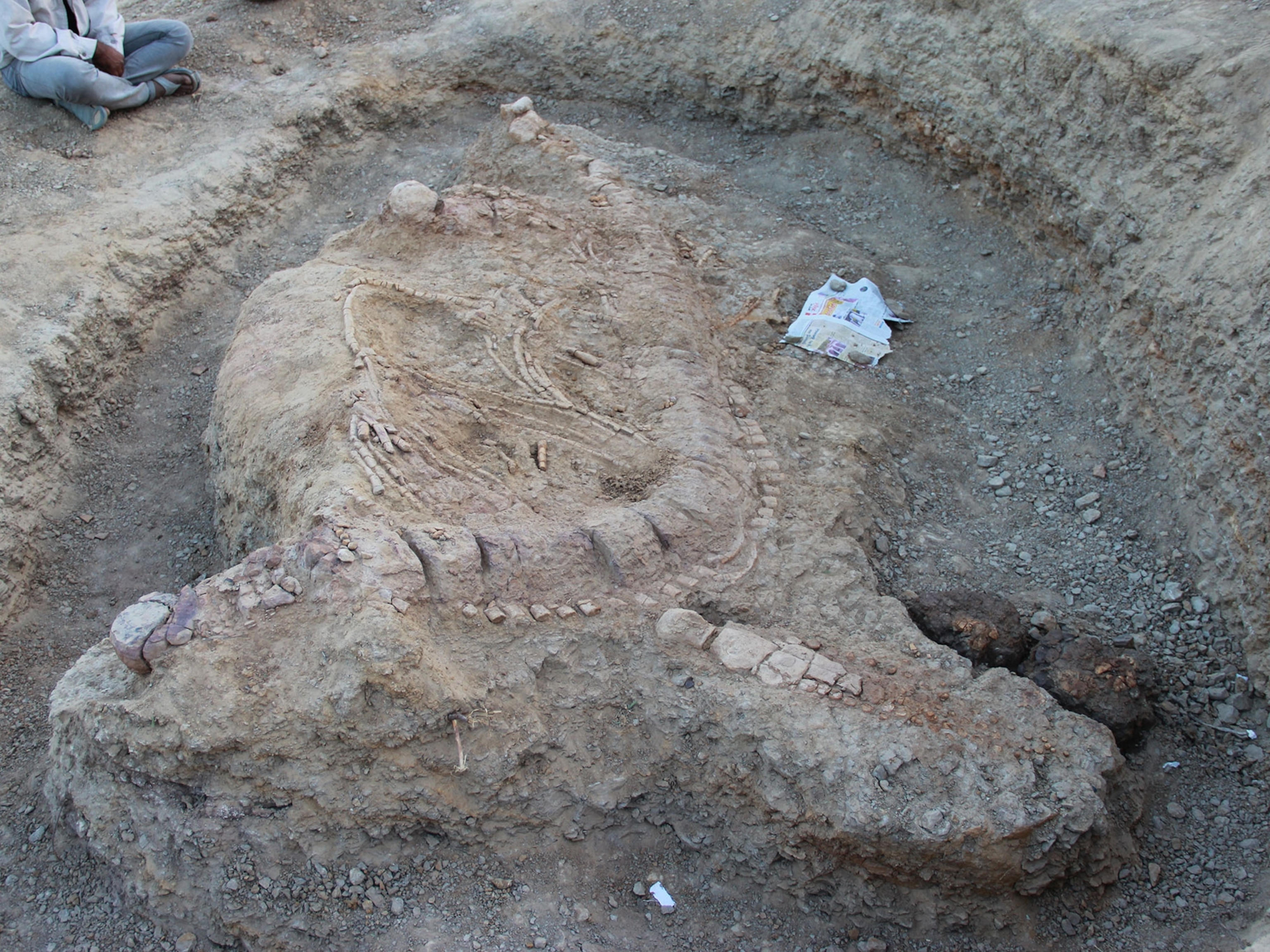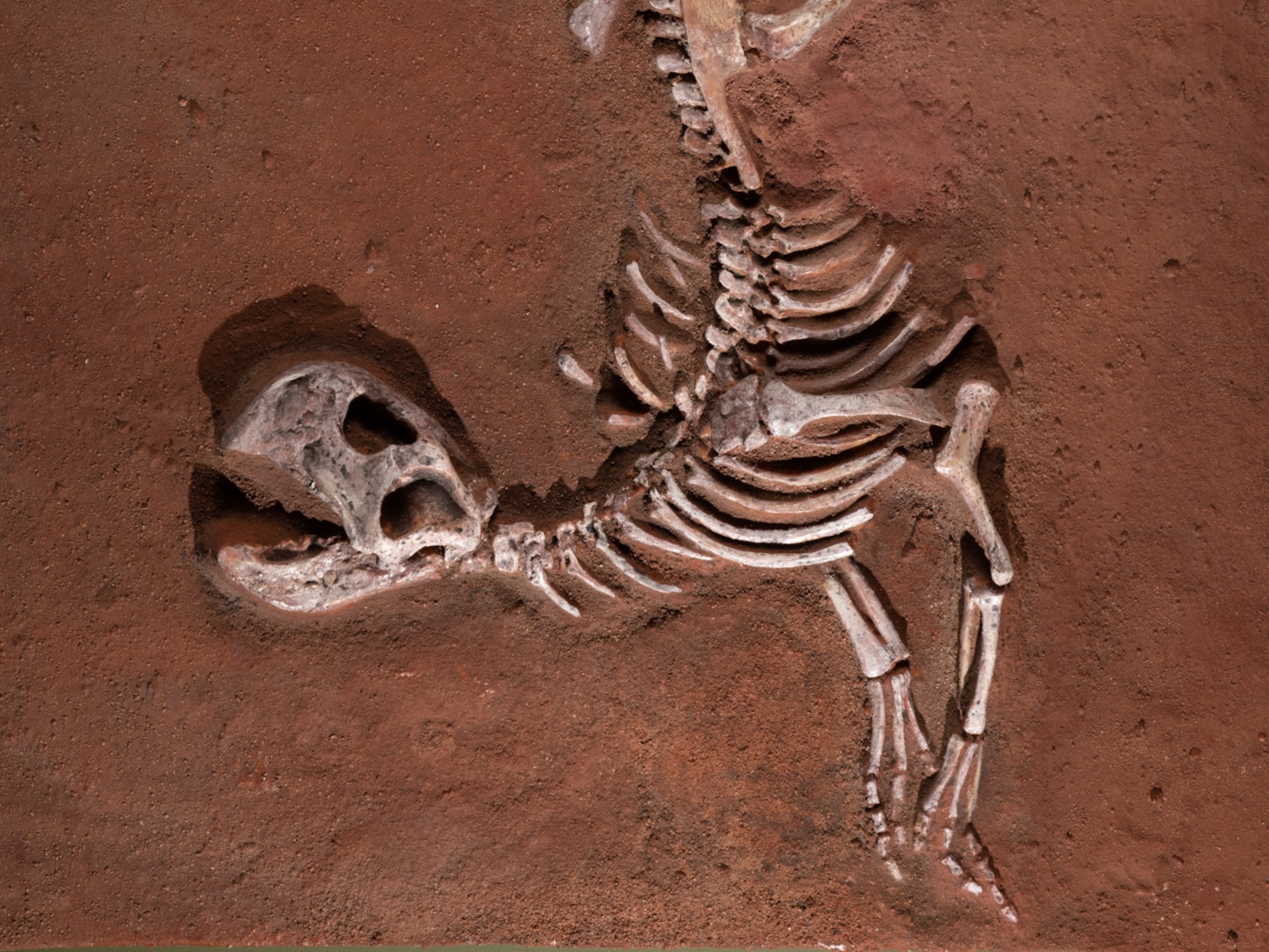Some 180 million years ago in what's now Germany, a dolphin-like reptile died and sank to the bottom of an ancient ocean. Remarkably, the creature's burial at sea preserved its body in stunning detail—including the first chemical clues that suggest these prehistoric animals had whale-like blubber.
The fossil, unveiled on December 5 in the journal Nature, preserves the body of a Stenopterygius, a type of marine reptile called an ichthyosaur that lived during the early Jurassic period. The animal's skin still bears folds and ripples, as well as cells that held some of the animal's pigmentation and the chemical traces of blubber. Controversially, researchers also claim that the remains still have vestiges of their original proteins.
“Not only can you look at these structures and identify them at the cellular level, there's traces of the original protein in there—this is the tip of the iceberg, into Jurassic Park-type stuff,” says study coauthor Benjamin Kear, a paleontologist at Uppsala University.
The research marks the latest effort by paleontologists to glean huge insights from fossils' smallest scales.
“This study really delves into the preservation of this animal in its entirety ... at a scale that has only become possible over the last few decades,” Virginia Tech paleontologist Caitlin Colleary, an expert on molecular preservation in fossils, writes in an email. “This study is another example of how molecular paleontology can help us to reimagine what these animals looked like when they were alive.”
Mind the gap
Before dinosaurs were even named by science, ichthyosaurs—literally “fish lizards”—captured the imaginations of 19th-century natural philosophers. With leathery skin, slender jaws, and bodies built for speed, the reptiles were the dolphin of the Mesozoic era, the time of dinosaurs. Today, the creatures are understood as evolutionary trendsetters.
“They came from lung-breathing reptiles on land, and pretty quickly became fish-shaped after 30 million years. Ichthyosaurs are the first; whales did it later,” says Ryosuke Motani, a paleontologist at the University of California, Davis, who studies ichthyosaurs. “They [also] have the largest eyes of all vertebrates, and some later species had the highest number of fingers: nine to 10 in one hand.” (At 85 feet long, an ichtyosaur found in the U.K. may be the largest that ever lived.)

For more than a century, people have found ichthyosaur fossils with traces of soft tissue, a consequence of the animals' deep-sea burials in low-oxygen sediments. The best-known of these fossils come from the shale quarries of Holzmaden, Germany. Many of the quarry's ichthyosaurs bear blackish outlines, which trace the animals' skin and fins.
Since the 1930s, researchers studying these outlines have suspected that ichthyosaurs had blubber, Motani says. In ichthyosaur fossils with body outlines, there's always a gap between the backbone and the ichthyosaur's upper surface—suggestive of ample soft tissue padding the animal's frame.
The challenge came in proving the blubber hunch with chemical evidence. Could researchers be sure that the outlines preserved the ichthyosaur itself, or simply the mats of bacteria that had feasted on the corpse? Did the fossil preserve hints of the animal's original fats and proteins? To find out, researchers needed to study the chemistry of an ichthyosaur in detail. But to prepare fossils, museums often carefully remove surrounding rock or treat them with stabilizing compounds, which could introduce contamination.
That's when Lund University paleontologist Johan Lindgren decided to source an uncontaminated ichthyosaur and then throw as many different chemical analyses at it as possible. Holzmaden's Urweltmuseum Hauff, which holds many of the site's fossils, happened to have a Stenopterygius specimen that fit the bill. Soon, 23 international researchers joined Lindgren's team.
“It really was an Alice-in-Wonderland kind of story,” Kear says. “We went down the rabbit hole, and it got deeper and deeper.”
Getting warmer
First, Lindgren's team analyzed the ichthyosaur's skin, which the fossil preserved in astounding detail. Researchers could make out the skin's individual layers and even the folds that formed as the animal decayed.
Strikingly, the researchers found traces of melanophores, specialized cells that contain the pigment melanin. While such a find dates back to the 1950s in ichthyosaurs, Lindgren's team took a decidedly 21st-century approach. Using high-powered spectroscopes and x-rays, researchers scanned the fossil for melanin and reconstructed the melanophores in 3-D. The team found that, like many marine animals today, the ichthyosaur's back was darker in color than its belly. This form of coloration, called countershading, would have helped the animal disguise itself in the water and regulate its body temperature.
Researchers also saw hints of blubber within the preserved skin. Chemical tests suggest that the layer isn't a modern contaminant or protein-based like the other skin layers. Instead, it's a yellowish, fatty band, approximately where dolphins and leatherback turtles have blubber today.

“To me, it looks quite convincing,” says Yale paleontologist Jasmina Wiemann, a Ph.D. student and expert on fossils' molecular preservation who was not involved with the study. “They did lots of methods, I have to say, it looks like a lot of work.”
At a minimum, the presence of blubber implies that ichthyosaurs could maintain a steady body temperature. While not conclusive evidence for warm-bloodedness like that in modern mammals—including whales and dolphins—the find jibes with a 2010 study that found that ichthyosaurs' body temperatures reached 95 degrees Fahrenheit.
Proteins in a bind
Perhaps the study's biggest and most contentious claim is that the ichthyosaur fossils still contain some of the animal's original proteins. If so, the ichthyosaur would have some of the oldest preserved biomolecules ever found, at approximately 180 million years old.
North Carolina State University paleontologist Mary Schweitzer, a coauthor on the paper, helped the team sniff out fossil proteins using antibodies. She has used this technique for decades, finding evidence of dinosaur collagen and other proteins under rigorous clean-room conditions. In this case, Schweitzer and her colleagues saw signs of hemoglobin in the ichthyosaur's liver, as well as hints of structural proteins such as collagen and keratin in the skin.
Her team analyzed the samples in a lab where modern animal tissues are forbidden. To further protect against false positives, they also screened their samples with multiple antibodies, including one that would highlight fossilized bacterial mats if they were present.
“We can differentiate where these antibodies bind, and they don't bind randomly,” Schweitzer says. “You don't see keratin [antibodies] binding everything; it only binds in what we interpret as skin.”
But some paleontologists have long criticized the antibody method as one prone to showing proteins that aren't really there. Recently, researchers reanalyzed one of Schweitzer's first published samples—fibers from the dinosaur fossil Shuvuuia deserti—with several methods. They found no evidence of proteins.
Related: Photos Show the Mystery and Beauty of Fossils
“I am worried that these antibody techniques are highly susceptible to false positives from consolidants [compounds used to stabilize fossils], contaminants, and other fossil organics,” Evan Saitta, the researcher at the Field Museum of Natural History who led the Shuvuuia reanalysis, writes in an email. “I would like these studies to include more control samples ... although the heterogenous nature of this sample might help to sort some of this out.”
The skepticism stems in part from the magnitude of Schweitzer and others' claims. If proteins really do preserve that well in the fossil record, researchers could directly study ancient animals' proteins and learn much more about how the creatures lived and evolved than bones alone can reveal. Future work on other ichthyosaurs, as well as more analysis of this study's Stenopterygius, should help clarify the matter.
“We're absolutely going to continue [studying this fossil],” Schweitzer says. “It's an amazing specimen.”
In the meantime, Kear welcomes the debate the team's study may provoke: “Bring it on!” he says. “It's only through this constant testing of the data that we're going to have any close idea of what's actually going on.”
































